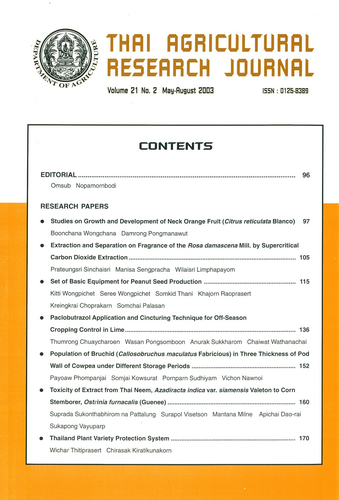Population of Bruchid (Callosobruchus maculates Fabricious) in Three Thickness of Pod wall of Cowpea under Different Storage Periods
DOI:
https://doi.org/10.14456/thaidoa-agres.2003.12Keywords:
cowpea, cowpea weevil (Callosobruchus maculatus Fabricious)Abstract
Cowpea weevil (Callosobruchus maculates Fabricious) is a serious storage pest in cowpea. It reduces seed germination and causes a foul smell. Female weevil lays eggs on mature green pods. The chance of bruchid larva gets through a pod wall to the seed of cowpea is high as 41%. Thickness of cowpea pod wall can lower that chance of bruchid down to as low as only 1%. The experiment was conducted to screen cowpea lines with pod wall which are not suitable to growth of cowpea bruchid. There were three groups of cowpea lines according to ghickness of their pod walls viewed by the stereo microscope. Those are thin wall group e.g. It 85F-2687 and KKU 305, medium thin wall; It 83S-742-13, TVx 1839-09D and thick wall; IT 82E-16 and TVx 4661-07D. Experimental design was RCB with 6 treatments (cowpea lines) and 4 replications. The cowpea was inspected for bruchid eggs in the field at 55 and 60 DAE but were not found due to a heavy rainfall. Some of harvested pods were shelled to measure their thickness by a micro stage. Then 200 g of dry pods analysed for nitrogen, tannin, protein, lipid and crude fiber. It was found that the number of bruchid learva in the cowpea seed was not significantly. How ever, cowpea line IT 82E-16 with its thickest pod wall (0.18 mm) was least damaged by the bruchid larva. This line also has low nitrogen and protein but high tannin and crud fiber.
Key words: cowpea, cowpea weevil (Callosobruchus maculates Fabricious)
Downloads
Published
How to Cite
Issue
Section
License

This work is licensed under a Creative Commons Attribution-NonCommercial-NoDerivatives 4.0 International License.
Thai Agricultural Research Journal



